EX-99.2
Published on December 4, 2020
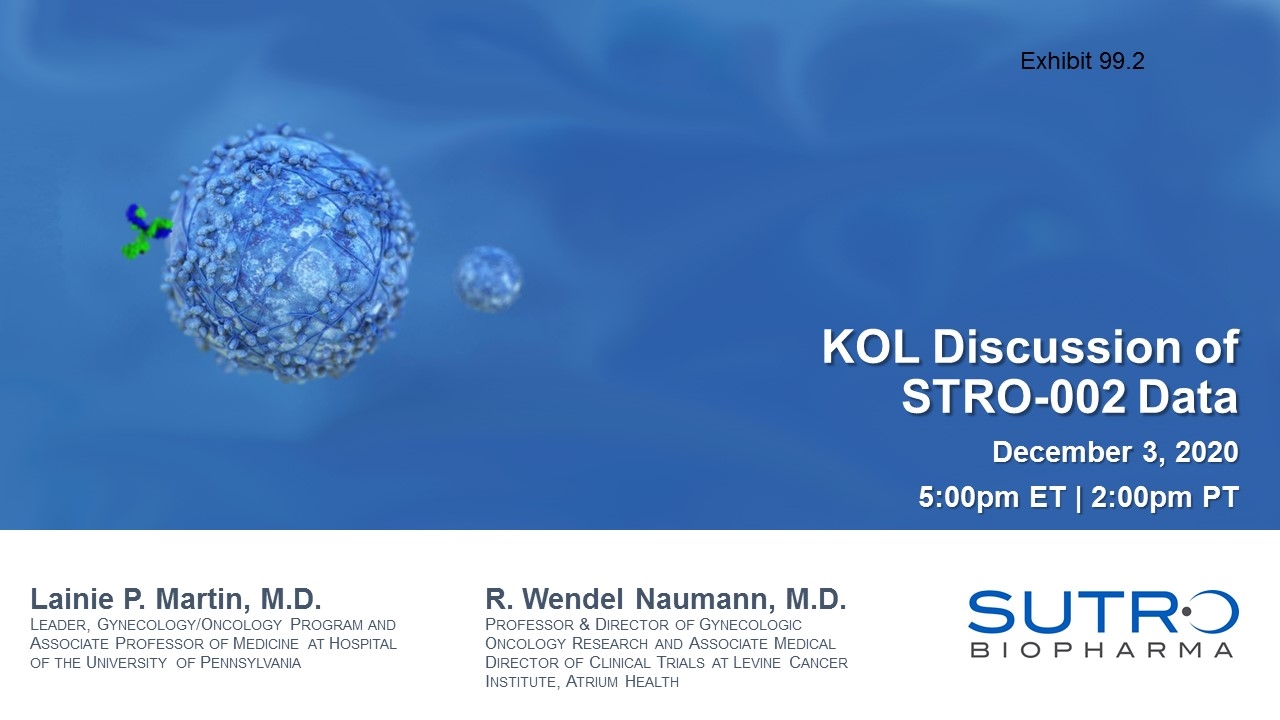
Lainie P. Martin, M.D. Leader, Gynecology/Oncology Program and Associate Professor of Medicine at Hospital of the University of Pennsylvania KOL Discussion of STRO-002 Data December 3, 2020 5:00pm ET | 2:00pm PT R. Wendel Naumann, M.D. Professor & Director of Gynecologic Oncology Research and Associate Medical Director of Clinical Trials at Levine Cancer Institute, Atrium Health Exhibit 99.2
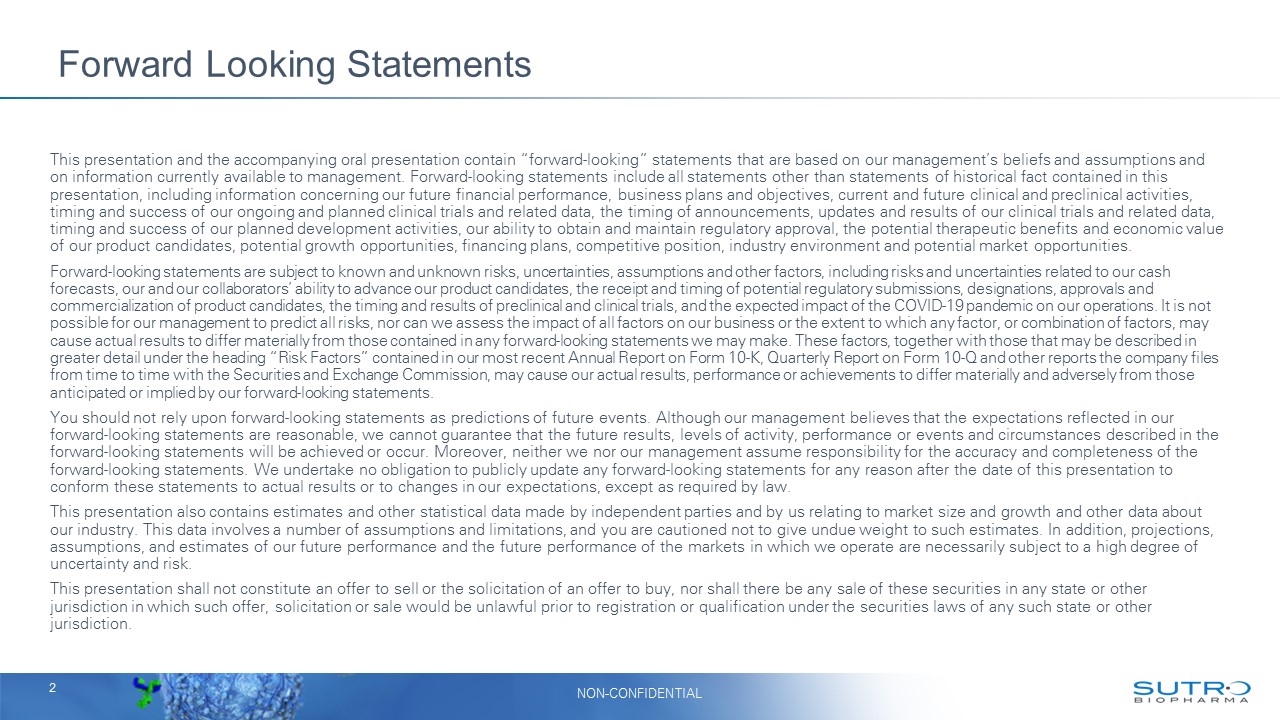
Forward Looking Statements This presentation and the accompanying oral presentation contain “forward-looking” statements that are based on our management’s beliefs and assumptions and on information currently available to management. Forward-looking statements include all statements other than statements of historical fact contained in this presentation, including information concerning our future financial performance, business plans and objectives, current and future clinical and preclinical activities, timing and success of our ongoing and planned clinical trials and related data, the timing of announcements, updates and results of our clinical trials and related data, timing and success of our planned development activities, our ability to obtain and maintain regulatory approval, the potential therapeutic benefits and economic value of our product candidates, potential growth opportunities, financing plans, competitive position, industry environment and potential market opportunities. Forward-looking statements are subject to known and unknown risks, uncertainties, assumptions and other factors, including risks and uncertainties related to our cash forecasts, our and our collaborators’ ability to advance our product candidates, the receipt and timing of potential regulatory submissions, designations, approvals and commercialization of product candidates, the timing and results of preclinical and clinical trials, and the expected impact of the COVID-19 pandemic on our operations. It is not possible for our management to predict all risks, nor can we assess the impact of all factors on our business or the extent to which any factor, or combination of factors, may cause actual results to differ materially from those contained in any forward-looking statements we may make. These factors, together with those that may be described in greater detail under the heading “Risk Factors” contained in our most recent Annual Report on Form 10-K, Quarterly Report on Form 10-Q and other reports the company files from time to time with the Securities and Exchange Commission, may cause our actual results, performance or achievements to differ materially and adversely from those anticipated or implied by our forward-looking statements. You should not rely upon forward-looking statements as predictions of future events. Although our management believes that the expectations reflected in our forward-looking statements are reasonable, we cannot guarantee that the future results, levels of activity, performance or events and circumstances described in the forward-looking statements will be achieved or occur. Moreover, neither we nor our management assume responsibility for the accuracy and completeness of the forward-looking statements. We undertake no obligation to publicly update any forward-looking statements for any reason after the date of this presentation to conform these statements to actual results or to changes in our expectations, except as required by law. This presentation also contains estimates and other statistical data made by independent parties and by us relating to market size and growth and other data about our industry. This data involves a number of assumptions and limitations, and you are cautioned not to give undue weight to such estimates. In addition, projections, assumptions, and estimates of our future performance and the future performance of the markets in which we operate are necessarily subject to a high degree of uncertainty and risk. This presentation shall not constitute an offer to sell or the solicitation of an offer to buy, nor shall there be any sale of these securities in any state or other jurisdiction in which such offer, solicitation or sale would be unlawful prior to registration or qualification under the securities laws of any such state or other jurisdiction.

Agenda for Today Topic Speaker Welcome and Introduction Forward Looking Statements Welcome and KOLs Introduction Ed Albini, Chief Financial Officer Bill Newell, Chief Executive Officer STRO-002 GM1 Data Discussion STRO-002 MOA Phase 1 Dose-Escalation Data Lainie P. Martin, M.D. STRO-002 Development Overview Phase 1 Dose-Expansion Design Regulatory Path Forward Arturo Molina, M.D., Chief Medical Officer Q&A Panel Lainie P. Martin, M.D. R. Wendel Naumann, M.D. Bill Newell Arturo Molina, M.D. Trevor Hallam, Ph.D., Chief Scientific Officer Ed Albini Closing Remarks Bill Newell
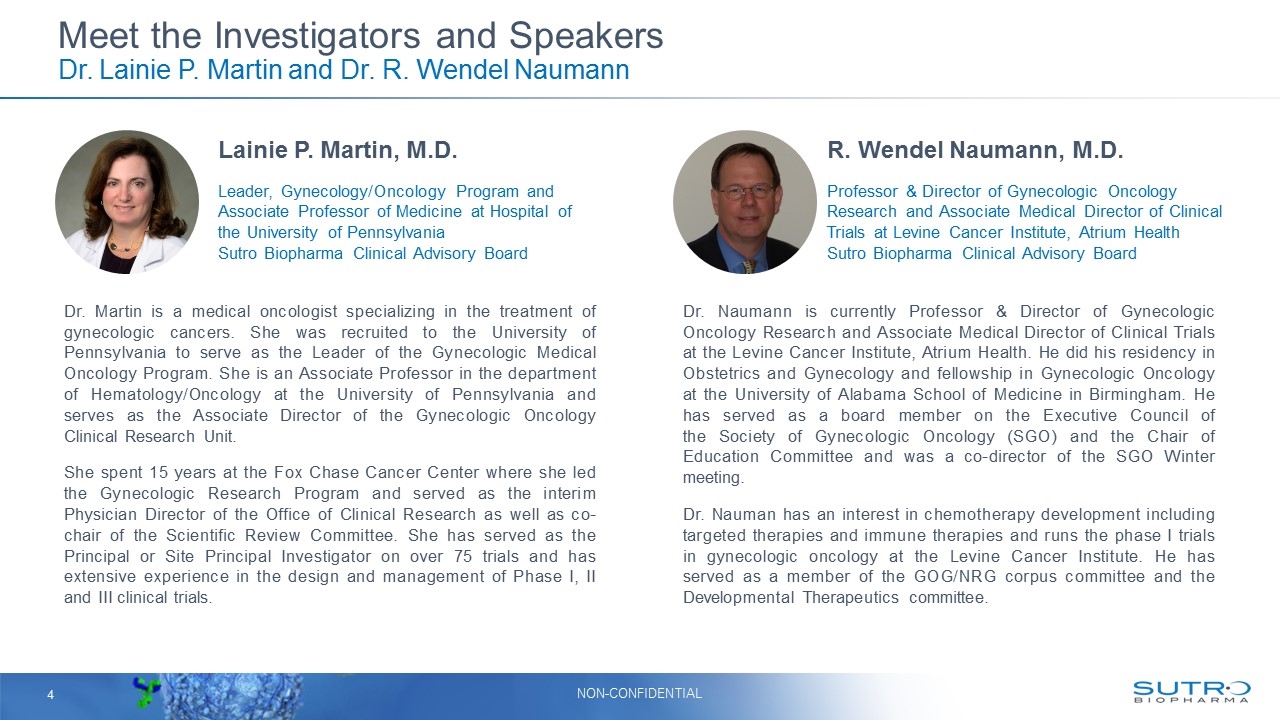
Meet the Investigators and Speakers Dr. Lainie P. Martin and Dr. R. Wendel Naumann Dr. Martin is a medical oncologist specializing in the treatment of gynecologic cancers. She was recruited to the University of Pennsylvania to serve as the Leader of the Gynecologic Medical Oncology Program. She is an Associate Professor in the department of Hematology/Oncology at the University of Pennsylvania and serves as the Associate Director of the Gynecologic Oncology Clinical Research Unit. She spent 15 years at the Fox Chase Cancer Center where she led the Gynecologic Research Program and served as the interim Physician Director of the Office of Clinical Research as well as co-chair of the Scientific Review Committee. She has served as the Principal or Site Principal Investigator on over 75 trials and has extensive experience in the design and management of Phase I, II and III clinical trials. Dr. Naumann is currently Professor & Director of Gynecologic Oncology Research and Associate Medical Director of Clinical Trials at the Levine Cancer Institute, Atrium Health. He did his residency in Obstetrics and Gynecology and fellowship in Gynecologic Oncology at the University of Alabama School of Medicine in Birmingham. He has served as a board member on the Executive Council of the Society of Gynecologic Oncology (SGO) and the Chair of Education Committee and was a co-director of the SGO Winter meeting. Dr. Nauman has an interest in chemotherapy development including targeted therapies and immune therapies and runs the phase I trials in gynecologic oncology at the Levine Cancer Institute. He has served as a member of the GOG/NRG corpus committee and the Developmental Therapeutics committee. Lainie P. Martin, M.D. Leader, Gynecology/Oncology Program and Associate Professor of Medicine at Hospital of the University of Pennsylvania Sutro Biopharma Clinical Advisory Board R. Wendel Naumann, M.D. Professor & Director of Gynecologic Oncology Research and Associate Medical Director of Clinical Trials at Levine Cancer Institute, Atrium Health Sutro Biopharma Clinical Advisory Board

FolRα-Targeting ADC STRO-002 GM1 Phase 1 Dose Escalation Data Discussion Lainie P. Martin, M.D. STRO 002
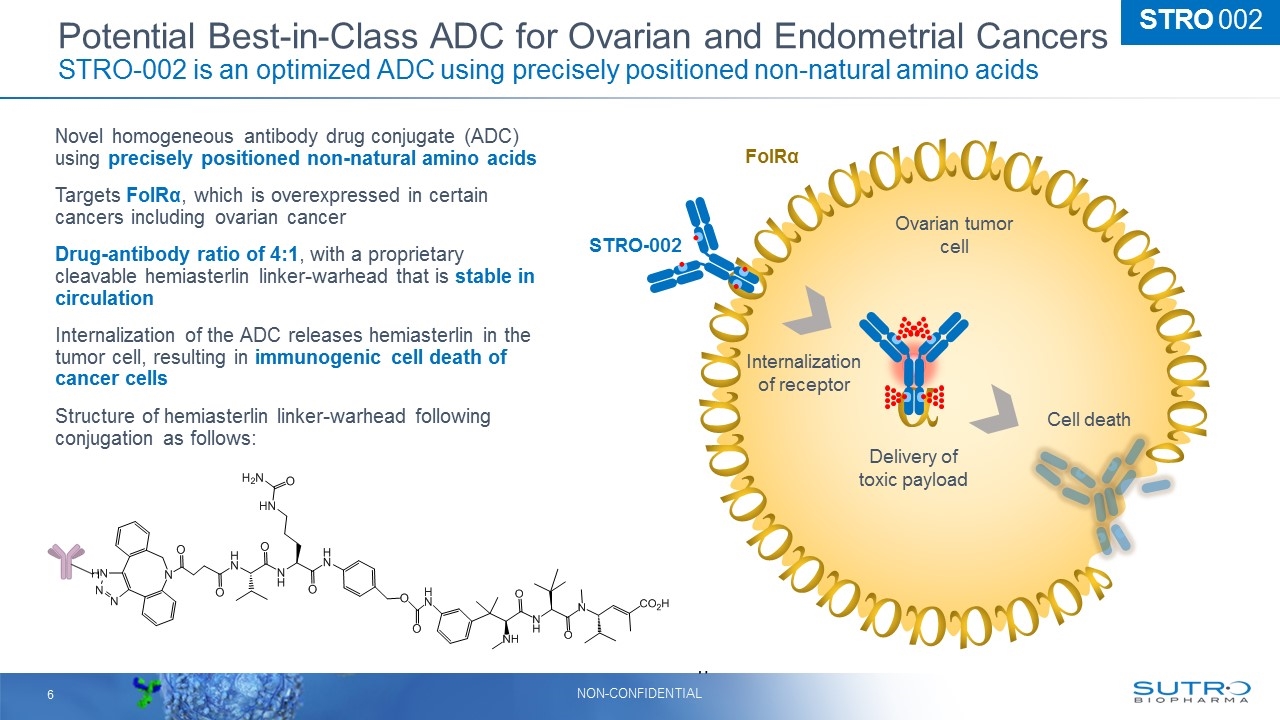
Novel homogeneous antibody drug conjugate (ADC) using precisely positioned non-natural amino acids Targets FolRα, which is overexpressed in certain cancers including ovarian cancer Drug-antibody ratio of 4:1, with a proprietary cleavable hemiasterlin linker-warhead that is stable in circulation Internalization of the ADC releases hemiasterlin in the tumor cell, resulting in immunogenic cell death of cancer cells Structure of hemiasterlin linker-warhead following conjugation as follows: Potential Best-in-Class ADC for Ovarian and Endometrial Cancers STRO-002 is an optimized ADC using precisely positioned non-natural amino acids STRO-002 Ovarian tumor cell FolRα Delivery of toxic payload Internalization of receptor Cell death STRO 002
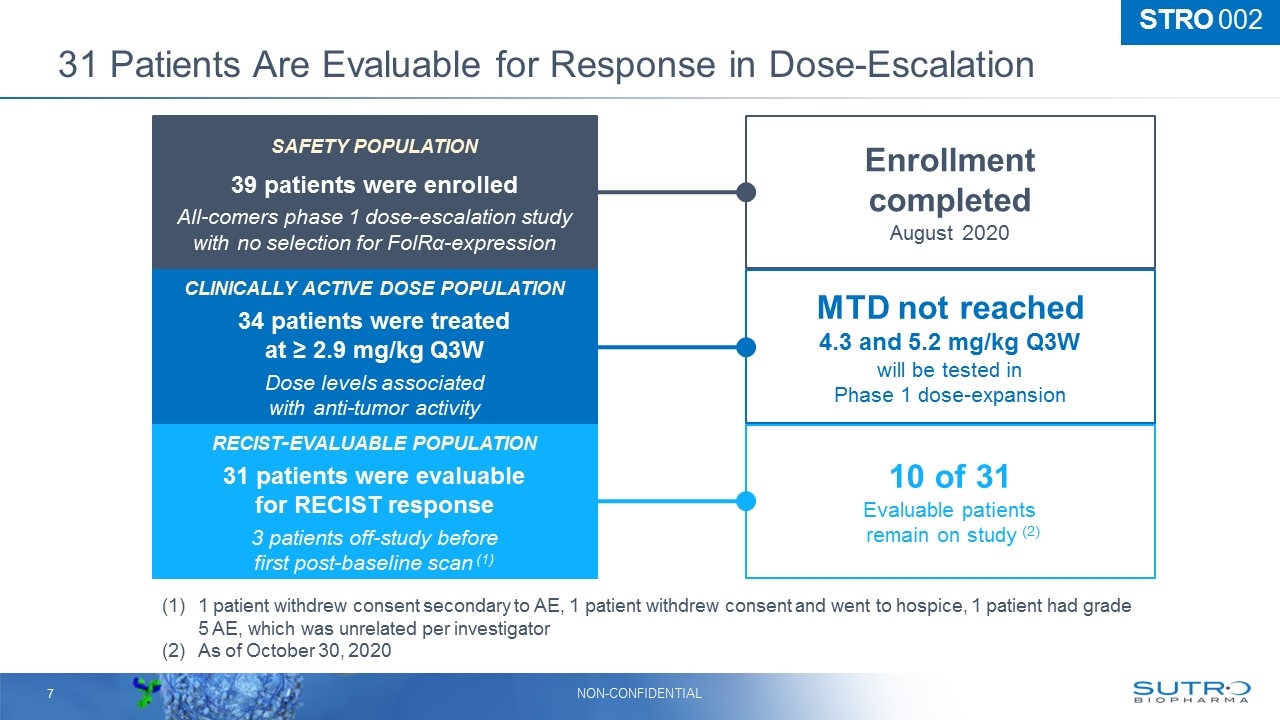
clinically active dose population 34 patients were treated at ≥ 2.9 mg/kg Q3W Dose levels associated with anti-tumor activity MTD not reached 4.3 and 5.2 mg/kg Q3W will be tested in Phase 1 dose-expansion 31 Patients Are Evaluable for Response in Dose-Escalation STRO 002 recist-evaluable population 31 patients were evaluable for RECIST response 3 patients off-study before first post-baseline scan (1) safety population 39 patients were enrolled All-comers phase 1 dose-escalation study with no selection for FolRα-expression 1 patient withdrew consent secondary to AE, 1 patient withdrew consent and went to hospice, 1 patient had grade 5 AE, which was unrelated per investigator As of October 30, 2020 Enrollment completed August 2020 10 of 31 Evaluable patients remain on study (2)

Phase 1 All comers, not selected on basis of FolRα levels IV infusion on Day 1 of 21-day cycles Activated at 10 sites First patient dosed March 2019 Key Objectives: Safety, Maximum Tolerated Dose, Recommended Phase 2 Dose, Pharmacokinetic Profile, Preliminary Efficacy (1) Illustration on dose-escalation excludes initial dose levels of 0.5-1.8mg/kg as they were not clinically active STRO 002 Dose Level Dose Level Dose Level Dose Level Dose Level Dose Level 5.6 mg/kg 6.4 mg/kg 5.2 mg/kg 6.0 mg/kg 4.3 mg/kg 2.9 mg/kg Part 1 Dose-Escalation Cohort in Ovarian (1) FolRα-Selected Endometrial N≤40 All-Comers Ovarian N≤40 Recommended doses for expansion cohorts Key Objectives and Endpoints: ORR, Duration of Response, Progression Free Survival, Safety, Pharmacokinetic Profile STRO-002 GM1, Phase 1 Study Has a Two-Part Design Phase 1 to establish safety and early signs of efficacy to inform registration-directed trial Part 2 Dose-Expansion Cohorts in Ovarian and Endometrial All-Comers Ovarian N≤40 Dose Level 4.3 mg/kg Dose Level 5.2 mg/kg

Ovarian Patients In Dose-Escalation Study Were Heavily Pre-Treated Median 6 prior lines of therapy, including SOC, bevacizumab, PARPi, CPI, and clinical trials Characteristic All Patients (N=39) Age, median 61 years (range, 48–79) Tumor type, n EOC 31 (80%) Fallopian tube 6 (15%) Primary peritoneal 2 (5%) ECOG PS, n 0 22 (56%) 1 17 (44%) Time since diagnosis, median 3.9 years (range, 0.6–17.0) Number of prior lines of therapy, median 6 (range, 2–11) Previous therapies, n Platinum 39 (100%) ≥ 3 prior platinum regimens 18 (46%) Taxanes 38 (97%) Bevacizumab 32 (82%) PARP inhibitors 23 (59%) Checkpoint inhibitors 8 (21%) Experimental therapy 14 (36%) STRO 002 STRO-002 Dose Levels (Q3W, n) All Patients (N=39) 0.5 mg/kg, 1.0 mg/kg, and 1.8 mg/kg 5 (13%) 2.9 mg/kg 3 (8%) 4.3 mg/kg 5 (13%) 5.2 mg/kg 12 (31%) 5.6 mg/kg 3 (8%) 6.0 mg/kg (1) 10 (26%) 6.4 mg/kg (1) 1 (3%) Data as of October 30, 2020 DLTs occurred in 2 patients: Grade 2 neuropathy/grade 3 arthralgia at 6.0 mg/kg Q3W Grade 3 bone pain at 6.4 mg/kg Q3W
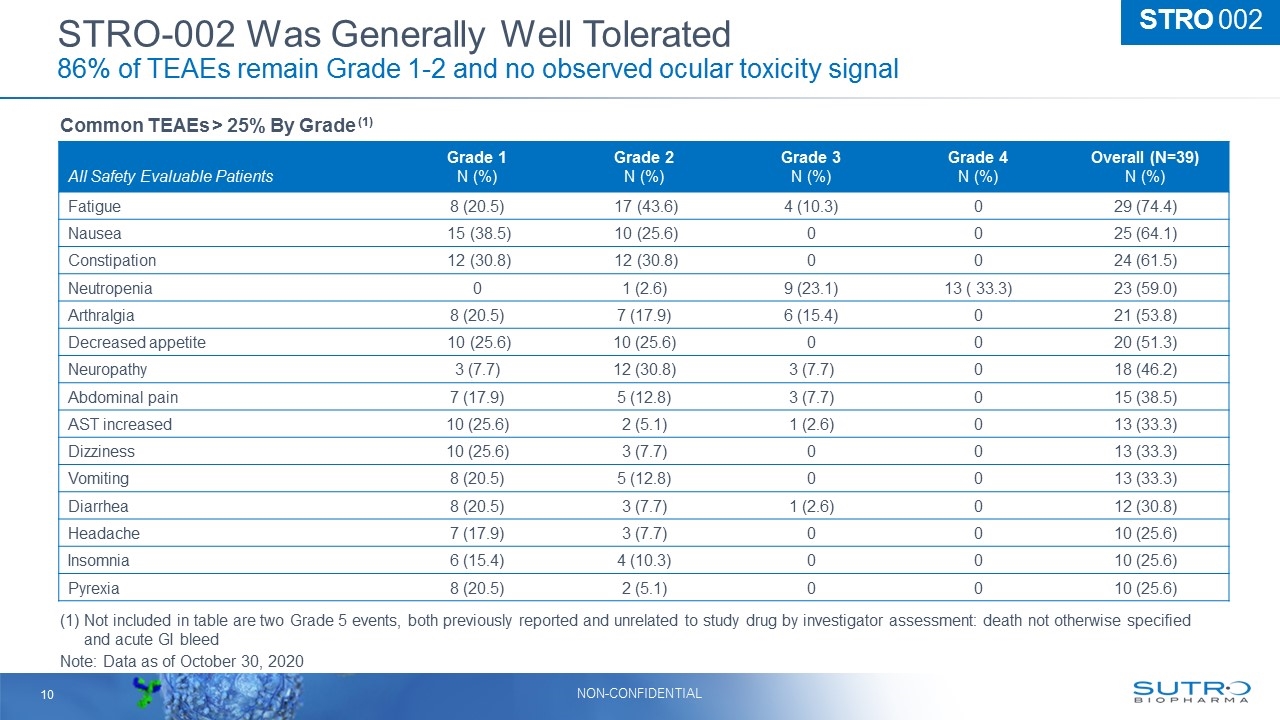
All Safety Evaluable Patients Grade 1 N (%) Grade 2 N (%) Grade 3 N (%) Grade 4 N (%) Overall (N=39) N (%) Fatigue 8 (20.5) 17 (43.6) 4 (10.3) 0 29 (74.4) Nausea 15 (38.5) 10 (25.6) 0 0 25 (64.1) Constipation 12 (30.8) 12 (30.8) 0 0 24 (61.5) Neutropenia 0 1 (2.6) 9 (23.1) 13 ( 33.3) 23 (59.0) Arthralgia 8 (20.5) 7 (17.9) 6 (15.4) 0 21 (53.8) Decreased appetite 10 (25.6) 10 (25.6) 0 0 20 (51.3) Neuropathy 3 (7.7) 12 (30.8) 3 (7.7) 0 18 (46.2) Abdominal pain 7 (17.9) 5 (12.8) 3 (7.7) 0 15 (38.5) AST increased 10 (25.6) 2 (5.1) 1 (2.6) 0 13 (33.3) Dizziness 10 (25.6) 3 (7.7) 0 0 13 (33.3) Vomiting 8 (20.5) 5 (12.8) 0 0 13 (33.3) Diarrhea 8 (20.5) 3 (7.7) 1 (2.6) 0 12 (30.8) Headache 7 (17.9) 3 (7.7) 0 0 10 (25.6) Insomnia 6 (15.4) 4 (10.3) 0 0 10 (25.6) Pyrexia 8 (20.5) 2 (5.1) 0 0 10 (25.6) STRO-002 Was Generally Well Tolerated 86% of TEAEs remain Grade 1-2 and no observed ocular toxicity signal Not included in table are two Grade 5 events, both previously reported and unrelated to study drug by investigator assessment: death not otherwise specified and acute GI bleed Note: Data as of October 30, 2020 Common TEAEs > 25% By Grade (1) STRO 002
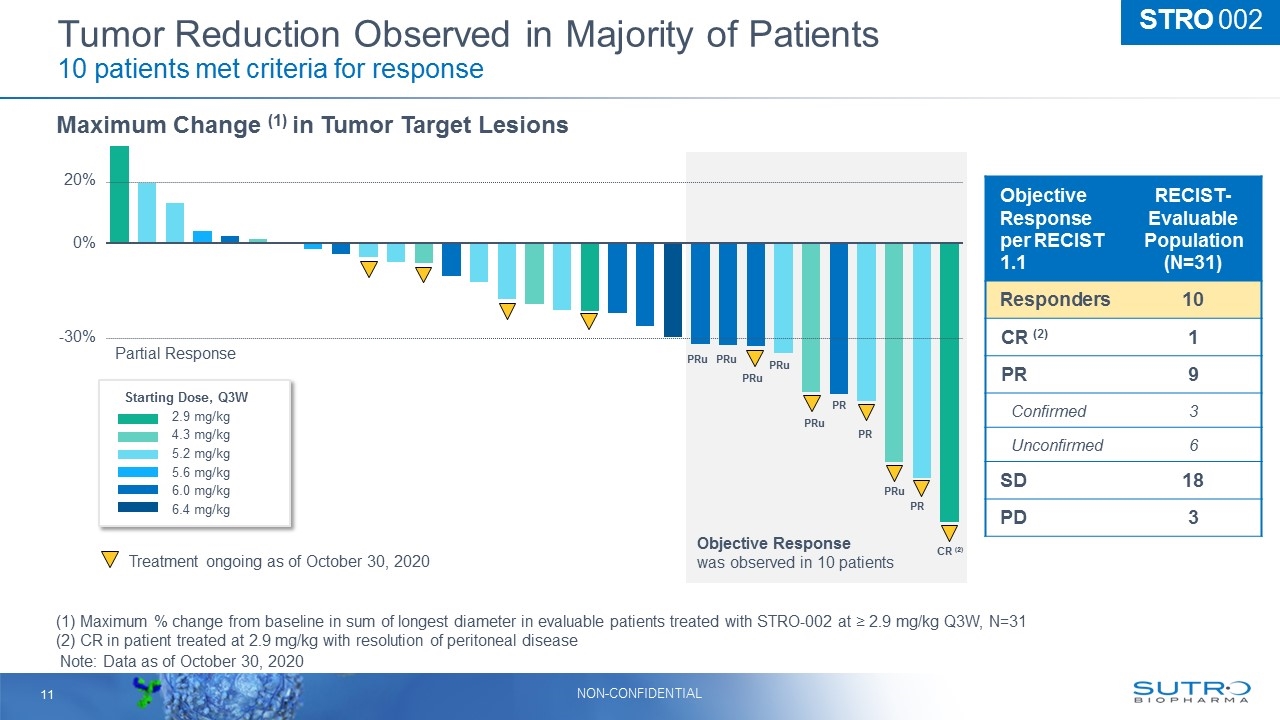
STRO 002 (1) Maximum % change from baseline in sum of longest diameter in evaluable patients treated with STRO-002 at ≥ 2.9 mg/kg Q3W, N=31 (2) CR in patient treated at 2.9 mg/kg with resolution of peritoneal disease Objective Response per RECIST 1.1 RECIST-Evaluable Population (N=31) Responders 10 CR (2) 1 PR 9 Confirmed 3 Unconfirmed 6 SD 18 PD 3 Objective Response was observed in 10 patients Treatment ongoing as of October 30, 2020 20% 0% -30% Partial Response Maximum Change (1) in Tumor Target Lesions Starting Dose, Q3W 2.9 mg/kg 4.3 mg/kg 5.2 mg/kg 5.6 mg/kg 6.0 mg/kg 6.4 mg/kg CR (2) PR PRu PRu PRu PRu PRu PRu PR PR Note: Data as of October 30, 2020 Tumor Reduction Observed in Majority of Patients 10 patients met criteria for response
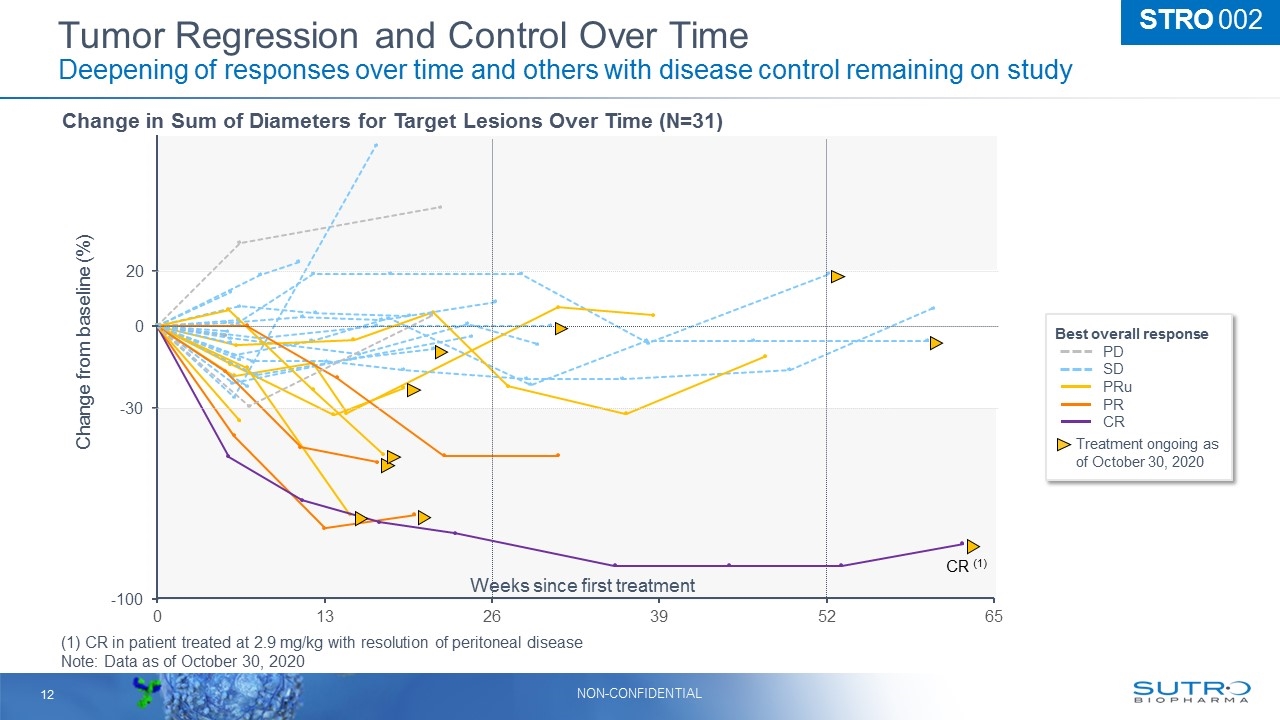
Change from baseline (%) Weeks since first treatment 20 -30 -100 0 Best overall response PD SD PRu PR CR Treatment ongoing as of October 30, 2020 Change in Sum of Diameters for Target Lesions Over Time (N=31) (1) CR in patient treated at 2.9 mg/kg with resolution of peritoneal disease Note: Data as of October 30, 2020 CR (1) Tumor Regression and Control Over Time Deepening of responses over time and others with disease control remaining on study STRO 002

Patient With Ongoing PR Remains on Study The patient achieved 74% tumor reduction after 4 cycles and remains on study (1) Confirmed PR after 4 cycles Baseline 3/16/20 06/29/20 57-year-old woman with platinum resistant ovarian cancer progressing after 4 prior regimens received STRO-002 at 5.2 mg/kg Q3W and remains on study treatment STRO 002 (1) Patient remains on study as of October 30, 2020

Weeks since first treatment Individual patients treated with STRO-002 Treatment Duration (1) and Response, Based on Evaluable Patients (N=31) Clinical Benefit Seen in Heavily Pre-Treated Patient Population Disease control rate of 74% at 12 weeks in RECIST-evaluable population STRO 002 Dose Level Treatment ongoing as of Oct 30, 2020 Dose adjustment PR CR Duration calculated as date of PD or time from first dose to last dose given (including 4 patients deriving clinical benefit post progression per investigator assessment) Note: Data as of October 30, 2020 2.9 mg/kg 3.5 mg/kg 4.3 mg/kg 5.2 mg/kg 5.6 mg/kg 6.0 mg/kg 6.4 mg/kg Disease Control Rate RECIST-Evaluable Population ≥ 52 weeks 4 (13%) ≥ 16 weeks 18 (58%) ≥ 12 weeks 23 (74%) PRu CR PRu PR PR PRu PR PRu PRu PRu Most patients on treatment beyond 12 weeks were treated at the 2.9-5.2 mg/kg dose levels
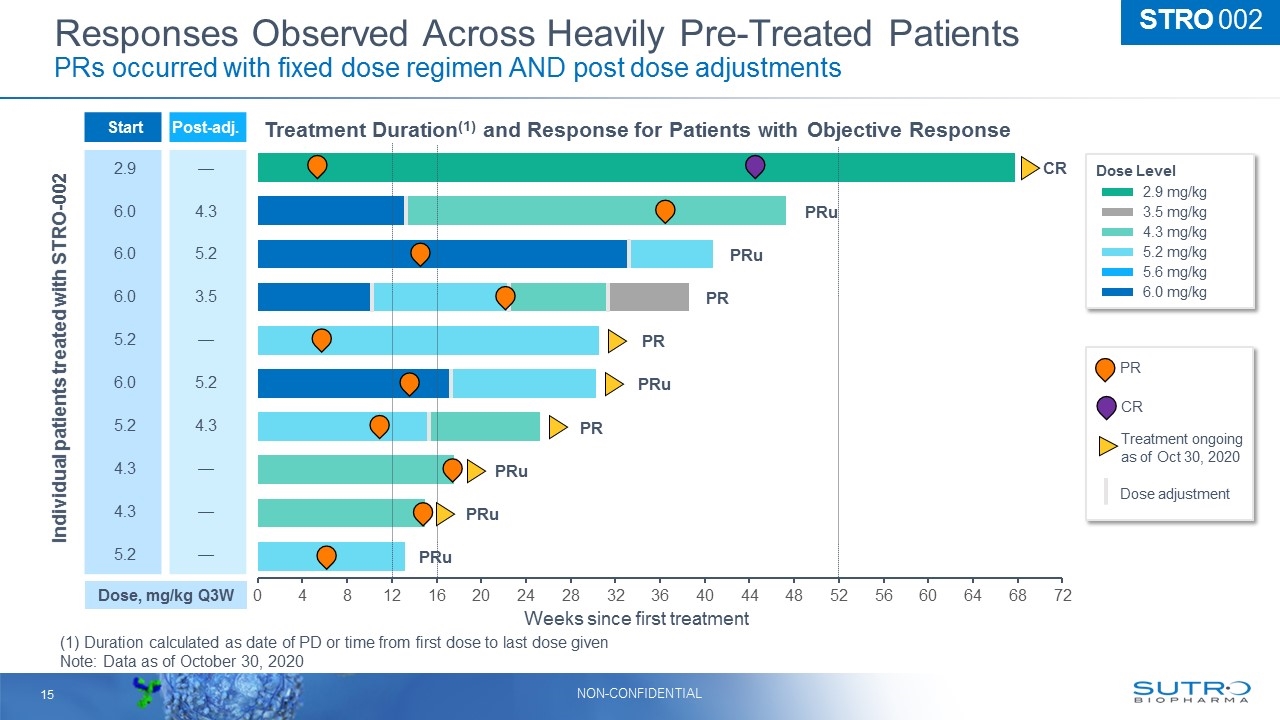
Responses Observed Across Heavily Pre-Treated Patients PRs occurred with fixed dose regimen AND post dose adjustments Duration calculated as date of PD or time from first dose to last dose given Note: Data as of October 30, 2020 Individual patients treated with STRO-002 Treatment Duration(1) and Response for Patients with Objective Response Start Post-adj. 2.9 — 6.0 4.3 6.0 5.2 6.0 3.5 5.2 — 6.0 5.2 5.2 4.3 4.3 — 4.3 — 5.2 — Dose, mg/kg Q3W Weeks since first treatment PRu CR PRu PR PR PRu PR PRu PRu PRu Dose Level 2.9 mg/kg 3.5 mg/kg 4.3 mg/kg 5.2 mg/kg 5.6 mg/kg 6.0 mg/kg Treatment ongoing as of Oct 30, 2020 Dose adjustment PR CR STRO 002

STRO 002 FolRα Expression by Immunohistochemistry (1) In emerging data, responses and anti-tumor activity observed across various FolRα expression levels H-score (Ventana FOLR1 assay) Individual Patients (N=13) PR SD PD PRu Best Overall Response (BOR) FOLR1 PS2+ Score: Weak/Absent Expression Moderate Expression High Expression PR 1 1 0 PRu 0 0 1 SD 3 1 4 PD 2 0 0 Assessed by Ventana FOLR1 expression assay based on available archival tissue from dose-escalation patients Note: Data as of October 30, 2020
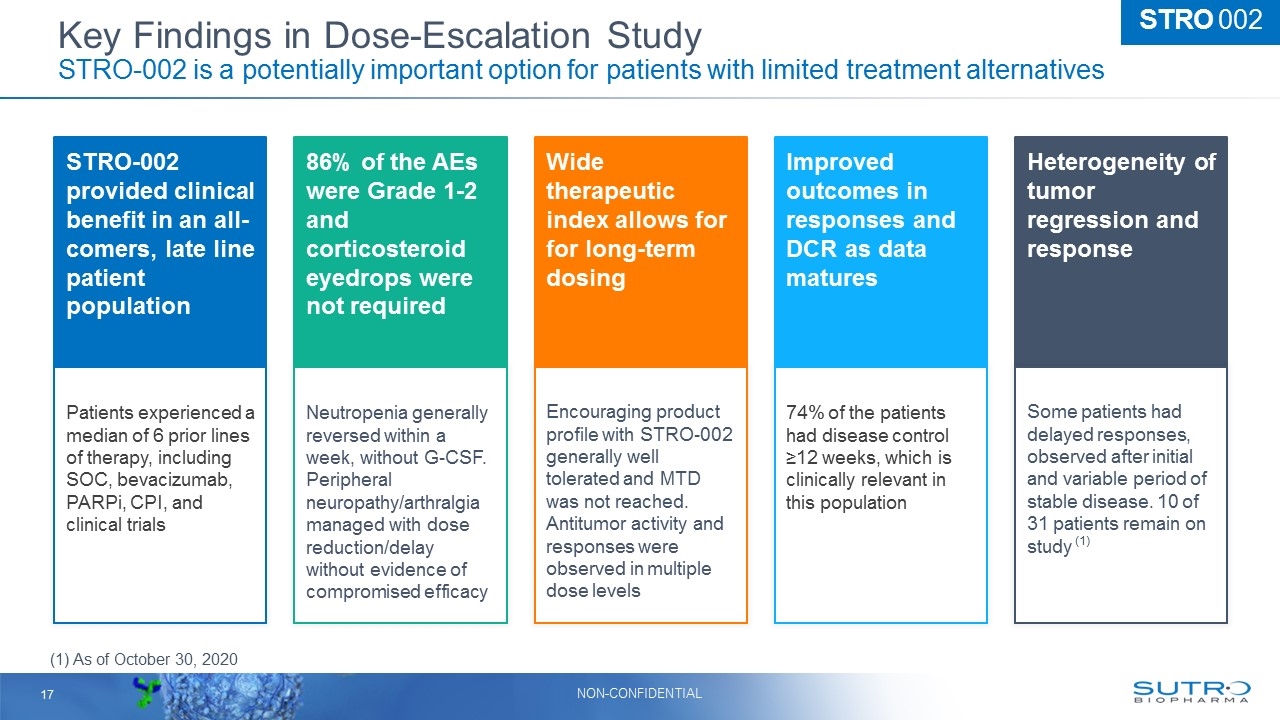
Key Findings in Dose-Escalation Study STRO-002 is a potentially important option for patients with limited treatment alternatives Neutropenia generally reversed within a week, without G-CSF. Peripheral neuropathy/arthralgia managed with dose reduction/delay without evidence of compromised efficacy 86% of the AEs were Grade 1-2 and corticosteroid eyedrops were not required Patients experienced a median of 6 prior lines of therapy, including SOC, bevacizumab, PARPi, CPI, and clinical trials STRO-002 provided clinical benefit in an all-comers, late line patient population 74% of the patients had disease control ≥12 weeks, which is clinically relevant in this population Improved outcomes in responses and DCR as data matures Encouraging product profile with STRO-002 generally well tolerated and MTD was not reached. Antitumor activity and responses were observed in multiple dose levels Wide therapeutic index allows for for long-term dosing Heterogeneity of tumor regression and response Some patients had delayed responses, observed after initial and variable period of stable disease. 10 of 31 patients remain on study (1) (1) As of October 30, 2020 STRO 002
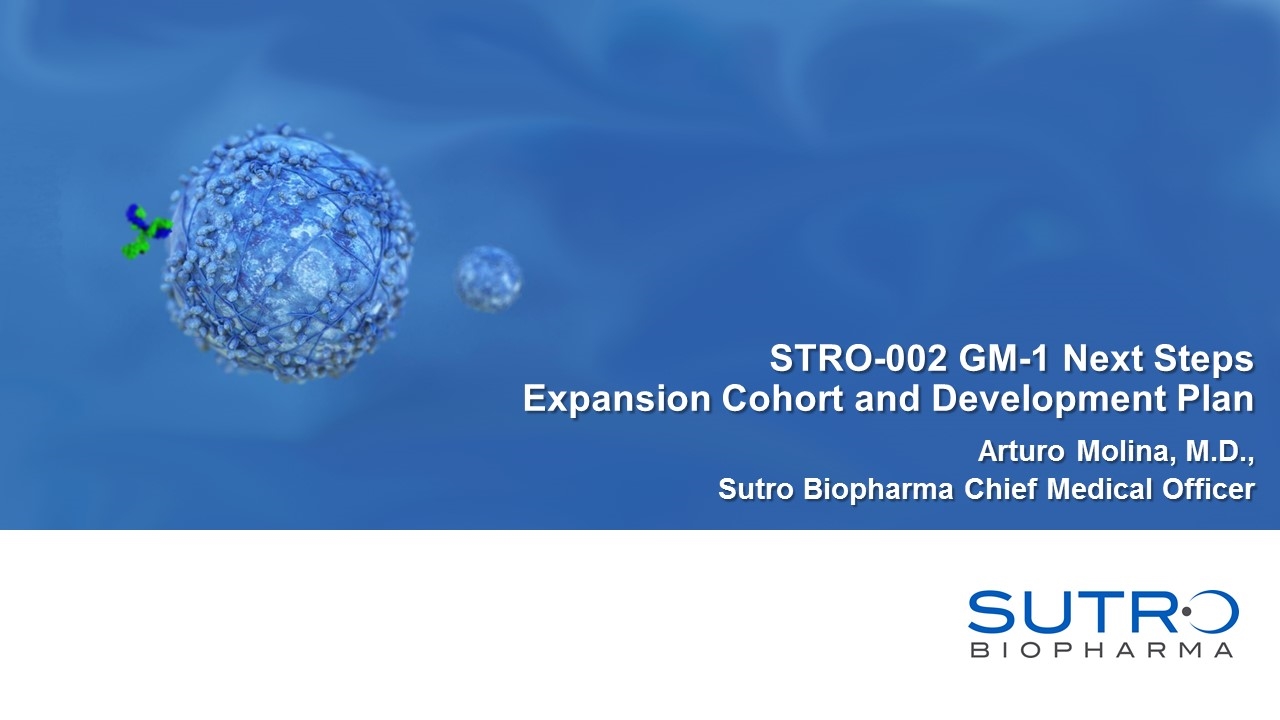
STRO-002 GM-1 Next Steps Expansion Cohort and Development Plan Arturo Molina, M.D., Sutro Biopharma Chief Medical Officer
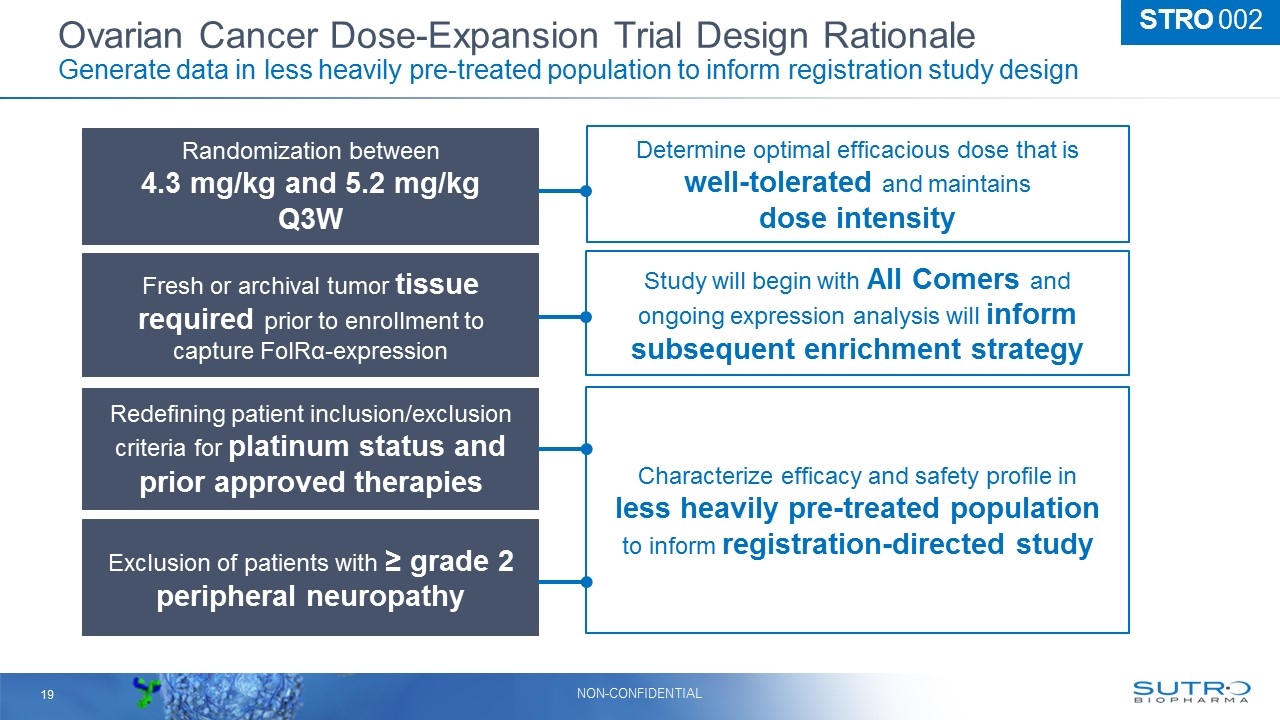
Determine optimal efficacious dose that is well-tolerated and maintains dose intensity STRO 002 Randomization between 4.3 mg/kg and 5.2 mg/kg Q3W Ovarian Cancer Dose-Expansion Trial Design Rationale Generate data in less heavily pre-treated population to inform registration study design Fresh or archival tumor tissue required prior to enrollment to capture FolRα-expression Exclusion of patients with ≥ grade 2 peripheral neuropathy Redefining patient inclusion/exclusion criteria for platinum status and prior approved therapies Study will begin with All Comers and ongoing expression analysis will inform subsequent enrichment strategy Characterize efficacy and safety profile in less heavily pre-treated population to inform registration-directed study
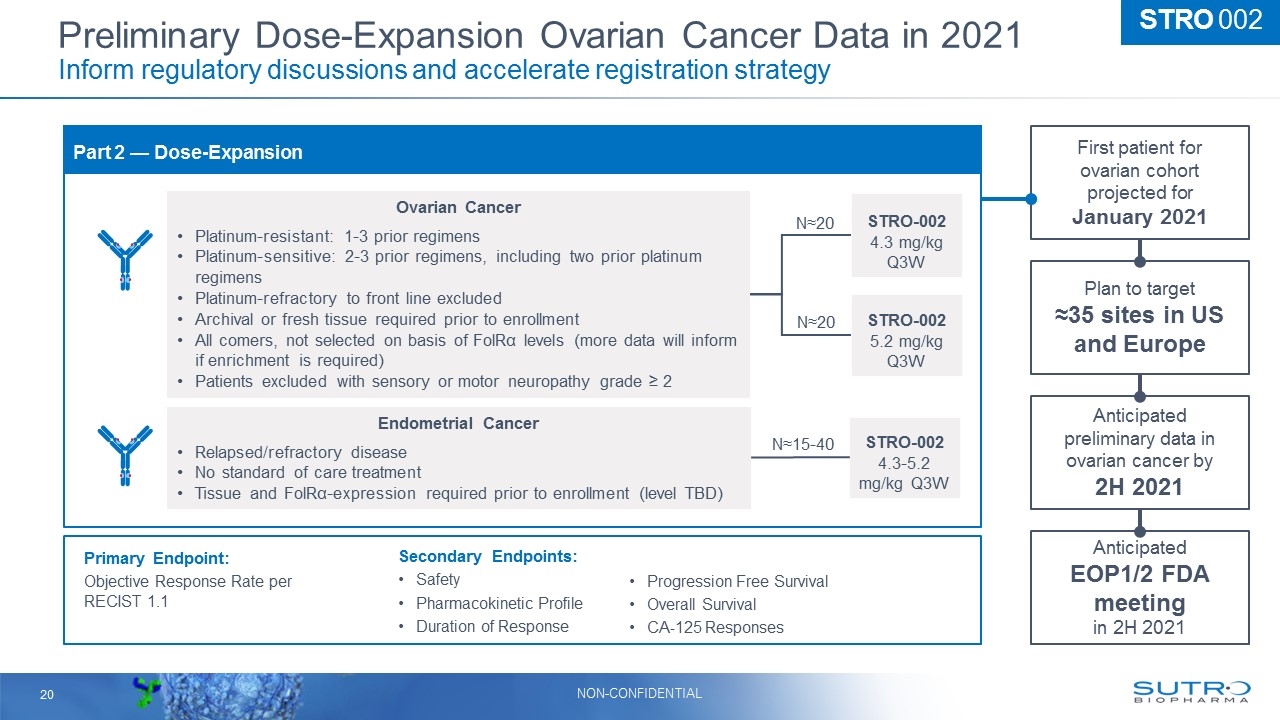
Part 2 — Dose-Expansion Primary Endpoint: Objective Response Rate per RECIST 1.1 STRO 002 Endometrial Cancer Relapsed/refractory disease No standard of care treatment Tissue and FolRα-expression required prior to enrollment (level TBD) Ovarian Cancer Platinum-resistant: 1-3 prior regimens Platinum-sensitive: 2-3 prior regimens, including two prior platinum regimens Platinum-refractory to front line excluded Archival or fresh tissue required prior to enrollment All comers, not selected on basis of FolRα levels (more data will inform if enrichment is required) Patients excluded with sensory or motor neuropathy grade ≥ 2 Preliminary Dose-Expansion Ovarian Cancer Data in 2021 Inform regulatory discussions and accelerate registration strategy Plan to target ≈35 sites in US and Europe First patient for ovarian cohort projected for January 2021 STRO-002 4.3 mg/kg Q3W STRO-002 5.2 mg/kg Q3W STRO-002 4.3-5.2 mg/kg Q3W N≈20 N≈20 N≈15-40 Anticipated preliminary data in ovarian cancer by 2H 2021 Secondary Endpoints: Safety Pharmacokinetic Profile Duration of Response Progression Free Survival Overall Survival CA-125 Responses Anticipated EOP1/2 FDA meeting in 2H 2021
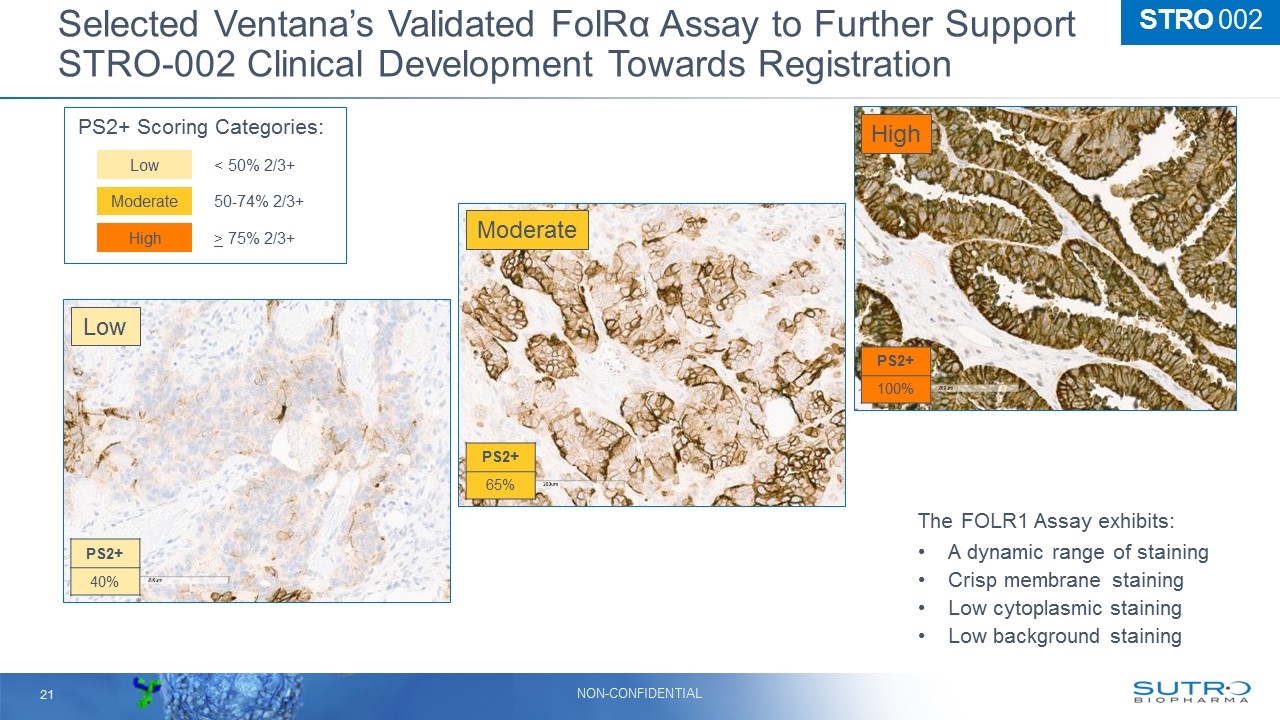
Moderate Low High PS2+ Scoring Categories: > 75% 2/3+ High 50-74% 2/3+ Moderate < 50% 2/3+ Low The FOLR1 Assay exhibits: A dynamic range of staining Crisp membrane staining Low cytoplasmic staining Low background staining PS2+ 40% PS2+ 65% PS2+ 100% Selected Ventana’s Validated FolRα Assay to Further Support STRO-002 Clinical Development Towards Registration STRO 002
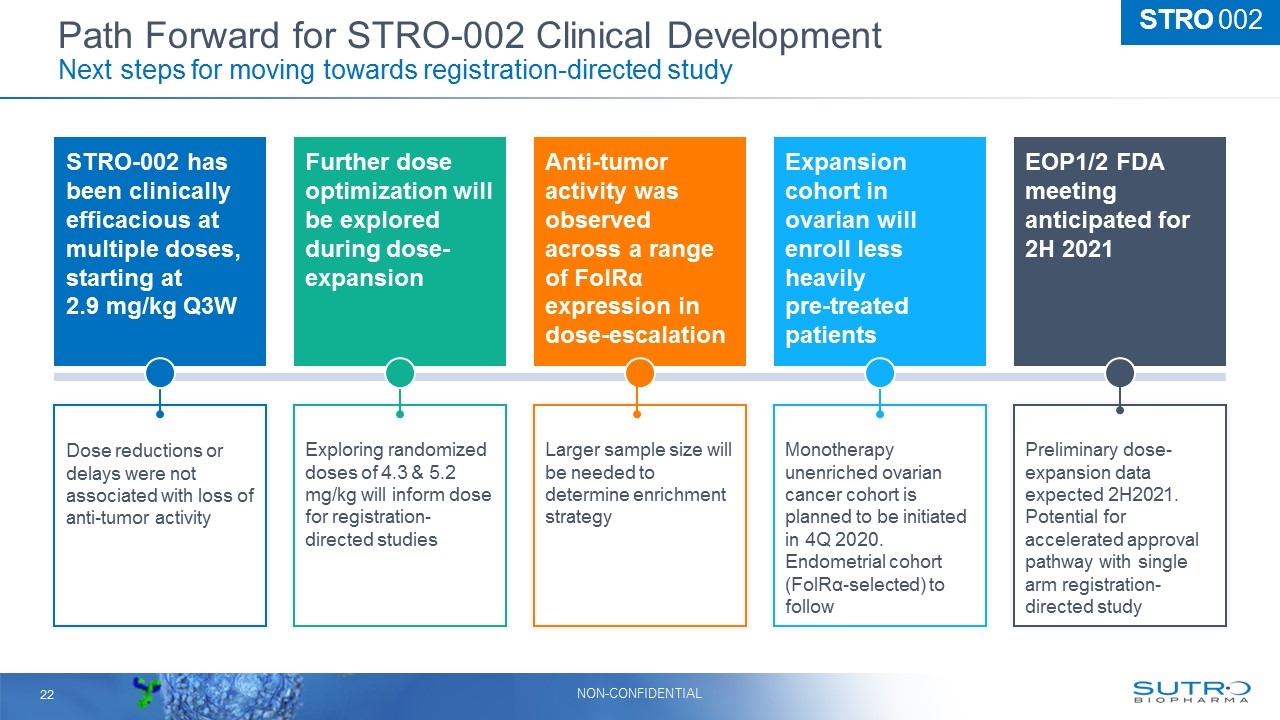
Path Forward for STRO-002 Clinical Development Next steps for moving towards registration-directed study Exploring randomized doses of 4.3 & 5.2 mg/kg will inform dose for registration-directed studies Further dose optimization will be explored during dose-expansion Dose reductions or delays were not associated with loss of anti-tumor activity STRO-002 has been clinically efficacious at multiple doses, starting at 2.9 mg/kg Q3W Monotherapy unenriched ovarian cancer cohort is planned to be initiated in 4Q 2020. Endometrial cohort (FolRα-selected) to follow Expansion cohort in ovarian will enroll less heavily pre-treated patients Larger sample size will be needed to determine enrichment strategy Anti-tumor activity was observed across a range of FolRα expression in dose-escalation EOP1/2 FDA meeting anticipated for 2H 2021 Preliminary dose-expansion data expected 2H2021. Potential for accelerated approval pathway with single arm registration-directed study STRO 002
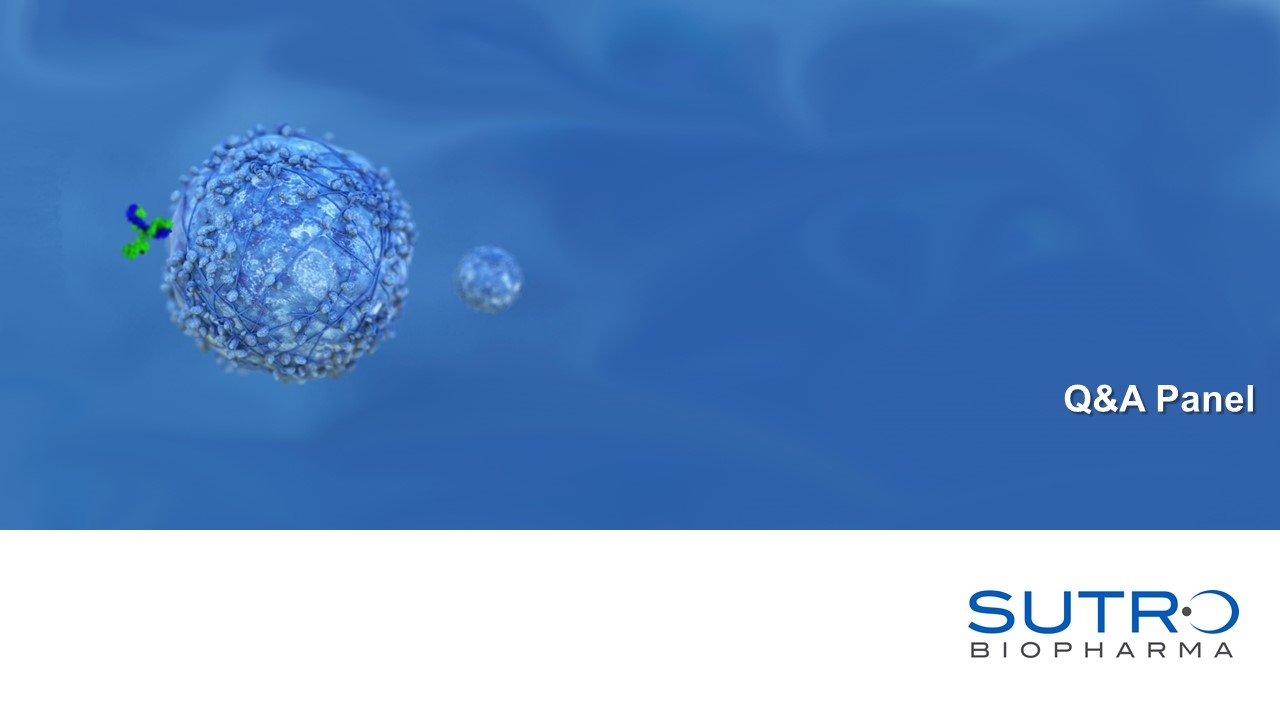
Q&A Panel
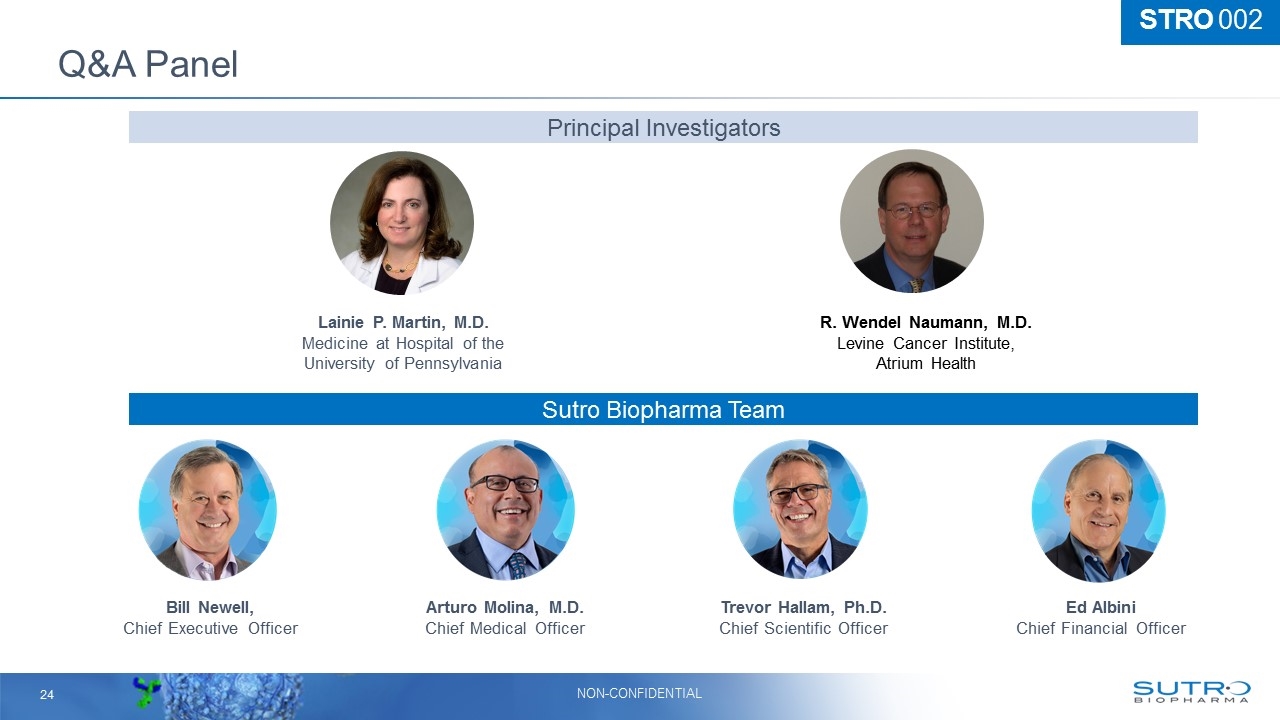
Q&A Panel STRO 002 Lainie P. Martin, M.D. Medicine at Hospital of the University of Pennsylvania R. Wendel Naumann, M.D. Levine Cancer Institute, Atrium Health Bill Newell, Chief Executive Officer Arturo Molina, M.D. Chief Medical Officer Trevor Hallam, Ph.D. Chief Scientific Officer Ed Albini Chief Financial Officer Sutro Biopharma Team Principal Investigators
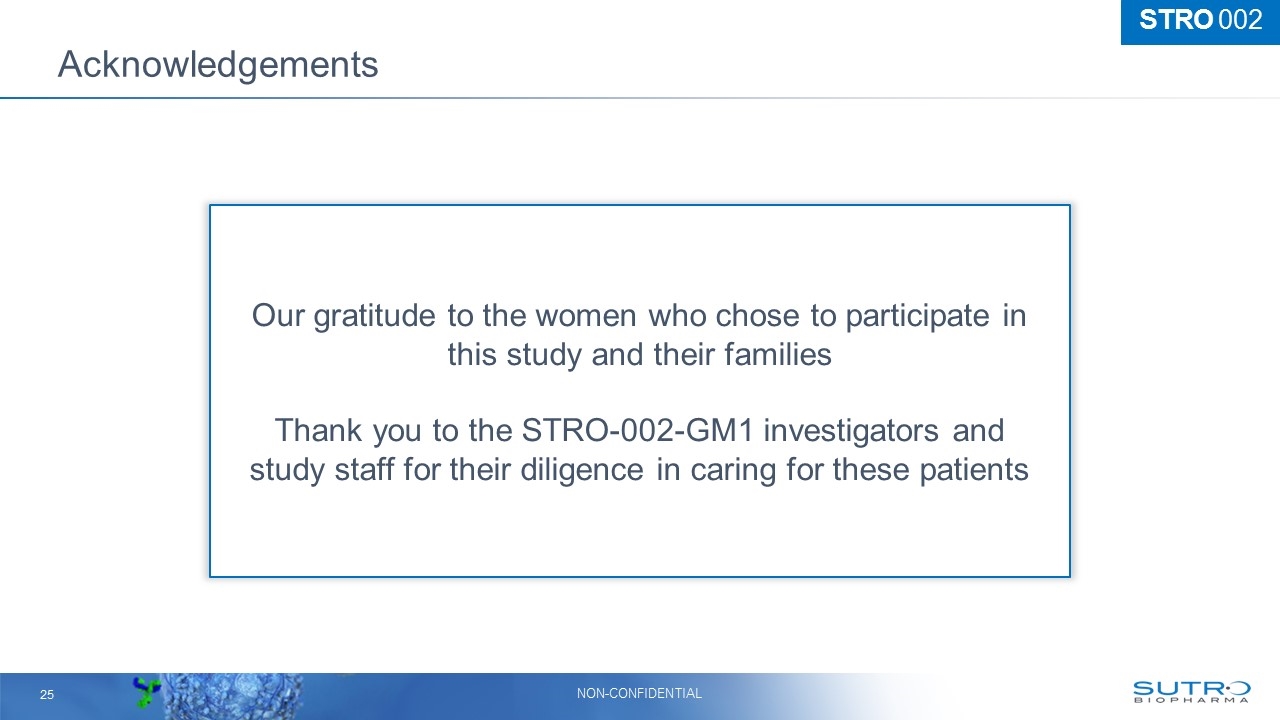
Acknowledgements Our gratitude to the women who chose to participate in this study and their families Thank you to the STRO-002-GM1 investigators and study staff for their diligence in caring for these patients STRO 002

Thank You